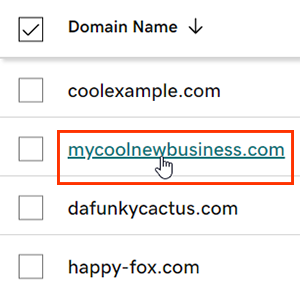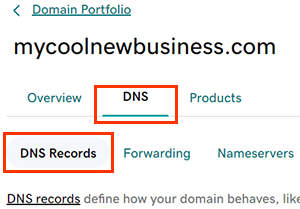Edit an SPF record
Edit your SPF (Sender Policy Framework) records any time to change which mail servers are permitted to send email on behalf of your domain. SPF records can help detect and prevent email spoofing. Only one SPF record will work on your domain at a time and we're unable to provide guidance on custom SPF records. Your domain must be using GoDaddy nameservers to edit an SPF record in your GoDaddy account.
Example: If your email is set up with Professional Email, Microsoft 365 from GoDaddy, Linux Hosting, Gen 4 VPS & Dedicated Hosting, or Media Temple Mail, your SPF record must have the Value set as v=spf1 include:secureserver.net -all to work properly.
- Sign in to your GoDaddy Domain Portfolio. (Need help logging in? Find your username or password.)
- Select an individual domain to access the Domain Settings page.

- Select DNS to view your DNS records.

- Select
 Edit next to the record you'll be editing.
Edit next to the record you'll be editing. - Edit the details for your SPF record.
- Name: The hostname or prefix of the record, without the domain name. Enter @ to put the record on your root domain, or enter a prefix, such as mail. The Name must follow these guidelines:
- Periods (.) are allowed but not as the first or last character
- Consecutive periods (…) are not allowed
- Cannot begin or end with a hyphen (-)
- 63 characters in a row not separated by a period (.)
Example: 63characters.63characters.coolexample.com
- 255 characters maximum
- Value: The SPF rule to indicate emails are only allowed from your mail server. The Value must follow these guidelines:
- Maximum 512 characters are allowed
- Only ASCII characters are allowed
- Professional Email, Microsoft 365 from GoDaddy, Linux Hosting, Gen 4 VPS & Dedicated Hosting, and Media Temple Mail use the following SPF record:
v=spf1 include:secureserver.net -all - If you have Microsoft 365 from GoDaddy and the Advanced Email Security add-on, go to the Email & Office Dashboard to find your SPF record.
- TTL (Time to Live): The amount of time the server should cache information before refreshing. The default setting is 1 hour.
- Name: The hostname or prefix of the record, without the domain name. Enter @ to put the record on your root domain, or enter a prefix, such as mail. The Name must follow these guidelines:
- (Optional) Select Add More Records to add multiple DNS records at the same time. If you change your mind, select
 Delete to remove any records that haven't been saved yet.
Delete to remove any records that haven't been saved yet. - Select Save to confirm your edits. If you added multiple records at the same time, select Save All Records.
- Domains with Domain Protection require additional identity verification. If you've had 2-step verification (2SV) turned on for at least 24 hours, enter the code we sent via SMS, or enter the code from your authenticator app. Otherwise, enter the one-time password we sent to the email address on your GoDaddy account.
Most DNS updates take effect within an hour but could take up to 48 hours to update globally.
Related steps
- Find out how SPF records can help prevent email spoofing.
- Add DKIM records to your Microsoft 365 organization.
- You can also add SPF, DKIM, or DMARC records to Linux Hosting, Gen 4 VPS hosting and Dedicated Hosting.
More info
- Create a DNS template to quickly apply DNS records to your domains.
- Turn on auto-renew to continue your domain registration uninterrupted.
- Set up 2-step verification for the best security on your domains and account.